| Published
on 5
Jun
2009 |
All rights reserved.
|
|
|
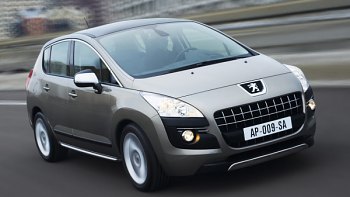
|
A crossover between hatchback, MPV and
SUV, but with so little SUV...
|
One
thing we learned through the years of watching cars is never to believe
official pictures. While these pictures show 3008 appear to be quite
well designed, in reality it looks clumsy, like a fat body bolted on an
undersized floorpan with too narrow tracks. Its big mesh grille is
hardly tasteful, while the square shape of the fenders not only look
odd but also amplifies the smallness of those 17-inch wheels. What
about the rearview? It’s so forgettable that we don't bother to put it
here.
Peugeot's new model 3008 is a crossover between hatchback, MPV and SUV,
something like Nissan Qashqai. While its competitors also include
Volkswagen
Tiguan, Ford Kuga and Dodge Caliber, the Peugeot put more
emphasis on quality and comfort instead of SUV toughness or offroad
ability. The latter can be seen in its lack of all-wheel drive
option. Compare with those cars, it is also more environmental
friendly, as reflected in its excellent drag coefficient of 0.296 and a
range
of fuel efficient engines. Therefore I decided not to deny it from the
gate of AutoZine.
As implied by its name, 3008 is derived from the 308 platform. Compare
with that car, it is considerably taller (at 1639mm vs 1498mm), longer
(4365mm vs 4276mm) and slightly wider (1837mm vs 1815mm), although its
wheelbase is just 5mm longer. Weight is up by around 130 kg.
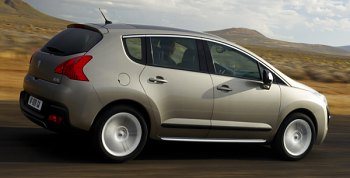
|
Never judge a car based on its
looks... it drives really nice indeed
|
Although
it remains a 5-seater, its seating arrangement is more flexible than
308. The 60/40-split rear seats and front passenger seat can fold flat
to place luggage. A split tailgate – consists of a large conventional
tailgate and a smaller bottom-hinged piece - opens to a large boot
which provides a parcel shelf adjustable at 3 levels. As expected,
occupants sit high in the car to have a commanding view over the road
like SUVs. There are lots of head and shoulder room for all passengers.
Although rear legroom is not much better than that of 308, the middle
passenger is benefited by a flat floor. The rear seats cannot slide
back and forth, so don’t assume it a MPV – that task will be left to
the forthcoming 5008.
While the cabin does not shine in versatility, it does deliver a very
upmarket feel. The dashboard employs expensive plastics and tastefully
decorated with chromes and lacquers. A row of 7 toggle switches and HUD
(head-up display) has flavours of aircraft cockpit. The driver-oriented
architecture and tall center tunnel appear like Audi. This is the best
yet cabin for Peugeot, even better than that of 308.
In order to reduce weight, 3008 employs an aluminum bonnet, plastic
front wings and ultra-high strength steel in its chassis (consists of
12.5% by weight). Laser welding also reduces the amount of overlapping
steel to save weight. The aforementioned low aerodynamic drag
compensates its large frontal area. Low rolling resistance tires and
fuel efficient engines also help improving its fuel economy. There are
5 engines on offer: 120hp 1.6-liter VVT Valvetronic, 150hp 1.6 THP VVT
direct injection turbo (both come from the joint-venture between BMW
and PSA), 110hp 1.6HDI and a pair of 2.0HDI with either 150hp or 163hp.
Transmission includes 5-speed manual, 6-speed manual and 6-speed
Tiptronic like its sibling.
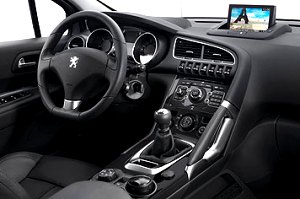
|
This is the best yet cabin for
Peugeot, even better than that of 308...
|
A
car as tall as 3008 could be clumsy to handle. Therefore Peugeot offers
it an adaptive suspensions called "Dynamic Roll Control". It links the
shock absorbers of the left and right rear wheels hydraulically. A
control valve in the hydraulic path normally opens to allow free
flowing of oil between the rear wheels. In cornering, the valve
closes to stop oil flowing, thus stiffens both shock absorbers and
limits body roll.
On the road, the Peugeot reminded us another thing we learned from the
past: never judge a car based on its looks. This is because it drives
really well. Soft suspensions give it a supple ride while Dynamic
Roll Control (standard on 1.6THP model) keeps its body movement tidy in
corner. Body roll and understeer are less pronounced than its tallness
suggested. The cabin is well insulated from wind and road noise. The
1.6 THP engine is smooth and eager. Although you can’t expect strong
performance, there is sufficient low-down torque to enable a brisk
driving manner. PSA’s diesel engines are also among the best in the
industry. Both 1.6 THP and 1.6 HDi are frugal, delivering 38.1 and 55.3
mpg respectively.
So styling aside, 3008 is actually quite lovely. Imagine had
Peugeot studio come back to form, it could have been easily a big hit. |
Verdict:     |
| Published
on 29
Sep
2011 |
All rights reserved.
|
|
3008 Hybrid4
|
|
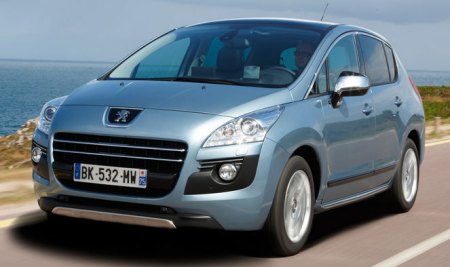
3008 Hybrid4 is the first
hybrid production car from PSA, also the world's first diesel-electric
hybrid. By mating the already very efficient 2000-bar common-rail
injection turbo diesel engine with a small electric motor, Peugeot
achieves a carbon footprint of just 99 grams per kilometer, placing it
among the greenest cars on the market. The 3008 is a pretty heavy
crossover, so its achievement is all the more impressive.
Peugeot's take on hybrid technology is very different from the
established parties. Its electric propulsion system is mechanically
separated from the internal combustion engine. The former is mounted
near the rear axle and drives the rear wheels only, while the
conventional engine and gearbox drive the front wheels as usual. There
is no mechanical linkage between the two systems. The major advantage
is its compatibility with the regular car, as the electric propulsion
system can be easily bolted on the rear axle without modifying the
original powertrain. It also realizes a part-time 4-wheel drive
function that we call "e-4WD".
To make room for the electric motor, 3008 Hybrid 4 replaces the regular
car's torsion-beam rear suspension with a new multi-link arrangement
which consists of an upper wishbone, two lateral arms and a toe-control
link each wheel. It is mounted on a subframe together with the electric
motor. The AC electric motor and power electronics are supplied by
Bosch, whereas the battery comes from Sanyo.
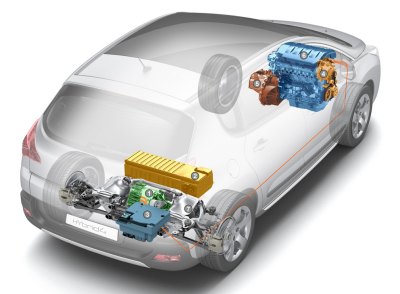
The 2.0HDi engine in this car produces 163 horsepower and 221 lbft of
torque, with the latter available from as low as 1580 rpm. It mates
with a 6-speed automated manual gearbox. The electric power system,
including motor, step-down gears, inverter, power electronics control
module and NiMH battery pack, are all located under the rear seat and
boot floor, something easy for the high-seating 3008, therefore boot
space is hardly altered. The electric
motor has a continuous output of 27 hp and 74 lbft, or for short burst
a maximum of 37 hp and 147 lbft. Because the electric motor has the
same bottom-biased characteristic as the diesel engine, the total
output is simply the sum of the two, i.e. 200 hp and 369 lb-ft. This
mean, although the 3008 Hybrid4 carries an additional 130 kilograms, it
provides better low-speed tractability and acceleration. The company
claims 0-60 mph is improved from 9.6 seconds to 8.0 seconds. Top speed,
however, is slightly worse, because the electric motor does not operate
at high speed in order to preserve battery.
So how does it work on road? At first, the car looks every bit
conventional, almost identical to the conventional car, both inside and
outside. The main differences lie on the instrument readings and a
rotary switch from which you can choose among 4 driving modes:
Auto: computer decides the combination of engine and motor power to
optimize fuel economy;
Sport: sportier gearshift pattern optimizes performance;
4WD: whenever the car slides, the motor is engaged to enhance traction;
ZEV: zero emission vehicle mode, i.e. electric propulsion only.
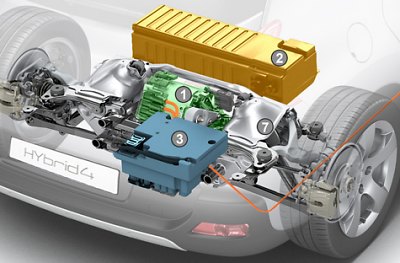
Due to the limited battery size, the ZEV mode is good for only 2.5
miles and a speed up to 31 mph. Although it is slightly better than
Toyota Prius (25 mph and 1 mile), the ZEV mode is more a gimmick.
Nevertheless, this is not to say the electric propulsion useless. Leave
it in Auto mode, the car switches between engine and motor regularly.
In town, the AC motor works alone for about a third of the time. At
higher speed, the diesel motor takes over and recharges the battery.
The transition between engine and motor is smooth, although the restart
of diesel engine does produce slightly more noise than the gasoline
engines in other hybrid cars. The 6-speed automated manual gearbox used
to be criticized for clunky gearshifts in the regular 3008, but in this
car it is well smoothened by the torque of electric motor, which is
deliberately programmed to fill the gaps. The turbo lag of the diesel
engine is also filled by the electric propulsion. Overall, the driving
experience is more refined and pleasant than the conventional version.
The extra low-end shove from AC motor offers better performance, too,
but it won't turn the 3008 into a hot hatch. This is still a heavy,
high and soft-riding crossover hatchback majoring on comfort and
refinement. We are glad that the extra weight has not ruined its
handling much though, thanks to the low position of that weight. The
only obvious drawback is a weaker braking.
The greatest achievement of the Hybrid4 is not how different it is, but
how normal it works while delivering ultra-low emission and fuel
consumption. It does that without sacrificing space, refinement and
performance. This would not have been possible without the combination
of diesel and electric power. Now the challenge is to get the cost down
as soon as possible. The 3008 Hybrid costs 20 percent more than the
diesel 3008 on which it is based, or at least 10 percent more than the
priciest Toyota
Prius. It might be worth the extra, but to entertain the majority it
has
to be cheaper.
Supplementary data: 3008
Hybrid4 vs rivals
|
Power
|
0-60
mph
|
CO2
emission
|
EU
combined fuel
consumption
|
Peugeot
3008 Hybrid 4
|
200
hp
|
8.0
sec
|
99
g/km
|
74.4
mpg
|
Toyota
Prius
|
134
hp
|
9.8
sec
|
92
g/km
|
70.6
mpg
|
Volkswagen
Golf 1.6TDi Bluemotion
|
105
hp
|
10.6
sec
|
99
g/km
|
74.3
mpg
|
Honda
Insight
|
100
hp
|
11.7
sec
|
101
g/km
|
64.2
mpg
|
|
Verdict:     |
|